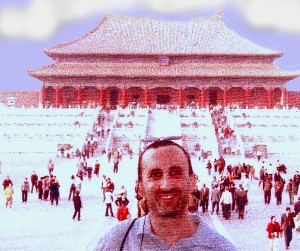|

One of the first places China tourists want to see and be seen through their camera lenses is Tiananmen Square. The world-famous plaza, located in Beijing, the nation's capital city is the largest public square in the world. It’s named for the sacred Tiananmen, translated as Gate of Heavenly Peace. This structure stands at one end of the Square as guardian doorway to the Forbidden City.
The Forbidden City dates back to the early 1400s, and through the centuries has served as palace, religious site, government quarters and residences of Chinese royal dynasties. When the Communist regime took over the city in 1949, a new kind of dynasty was created to be honored on the Square.
Now, instead of traditional Chinese religious and emperor names, there are more contemporary titles, including the Monument to the People's Heroes, the Great Hall of the People, and Chairman Mao Zedong Memorial Hall.
In case any visitor would question who's in charge, there's the daily raising of a big red flag, accompanied by goose-stepping honor guards. Tiananmen Square has served as the often-disturbing vortex of China's capital for centuries. It was a ceremonial site through the various ruling dynasties, then as information center during the brief years of several republics in the first half of the 20th Century. It now serves as the symbol of the Communist government.
The most notorious modern event on the Square happened in June 1989. Following 40 years of strict Communist political and economic control, young Chinese students came out to the Square to protest and demand democratic reforms. After confrontations with police and army units, many of the students were killed in the streets, while others were arrested and imprisoned.
Although the student protests were brutally suppressed, within just a few years, most of their yearnings for freedom were realized, and gradually the entire Chinese government and economy evolved into something new. The change wasn't because of guns and revolutionary battles, but by that dirty word in the vintage Communist vocabulary: capitalism.
Today, when visitors come to Beijing and can stroll freely around Tiananmen Square, they’ll see the flag and the strutting soldiers. However, no longer are there obedient platoons of workers in drab gray uniforms marching around waving little red books. Instead, visitors may mix with friendly, well-dressed residents, happy children, frisky teenagers and business-suited tech workers carrying laptops and brief cases.
For those who want to spend more than just a few moments with a tour group in the Tiananmen Square and Forbidden City areas, there are many hotels within walking distance. There's the Tiananmen Square Hotel, Holiday Inn Temple of Heaven, Jianquo Hotel, the high-rise Kerry Centre Hotel, Shangri-La Hotel, St. Regis, Grand Mercure Xidan, Crowne Plaza, Five Star Grande Hotel and Novotel Xin Qiao.
Considering Beijing is one of the biggest and busiest cities in the world, hotel prices there are surprisingly reasonable. Modern, well-equipped and comfortable rooms that would cost $300 or more in New York or London, run an average of $75 a night. Many hotels in the Square area and elsewhere in the city offer information and guided tours of Tiananmen Square and other historic sites in Beijing.
For Tiananmen Square visitor information, check with the Chinese Embassy in Washington (202-338-6688) or email at www.china-embassy.org. You may also contact its consulate offices in New York (212-967-2336), Chicago (573-3070), Houston (713-520-1462), San Francisco (415-674-2900) and Los Angeles (213-807-9088). Or go online to www.travelchinaguide.com |

